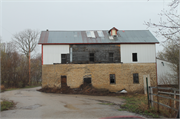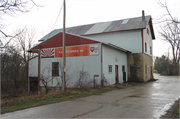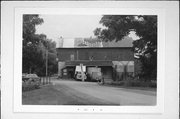Property Record
N6920 HOOPERS MILL LANE
Architecture and History Inventory
| Historic Name: | HOOPER MILL |
|---|---|
| Other Name: | |
| Contributing: | |
| Reference Number: | 6623 |
| Location (Address): | N6920 HOOPERS MILL LANE |
|---|---|
| County: | Jefferson |
| City: | |
| Township/Village: | Aztalan |
| Unincorporated Community: | HOOPER'S MILL |
| Town: | 7 |
| Range: | 14 |
| Direction: | E |
| Section: | 6 |
| Quarter Section: | SE |
| Quarter/Quarter Section: | SW |
| Year Built: | 1847 |
|---|---|
| Additions: | |
| Survey Date: | 19742012 |
| Historic Use: | mill |
| Architectural Style: | Astylistic Utilitarian Building |
| Structural System: | |
| Wall Material: | Stone - Unspecified |
| Architect: | |
| Other Buildings On Site: | |
| Demolished?: | No |
| Demolished Date: |
| National/State Register Listing Name: | Not listed |
|---|---|
| National Register Listing Date: | |
| State Register Listing Date: |
| Additional Information: | Richard and Thomas Hooper, brothers from Cornwall, England, immigrated to the United States with their father and settled on a farm in the Town of Palmyra in 1846. There, Richard apprenticed under a shoemaker, and Thomas was trained as a stoneworker. Thomas began working at a quarry owned John M. Brown, who had plans to construct a house and grist mill on the Rock Creek in the Town of Milford. Thomas cut stones that were used to construct the mill and house, moved to the Town of Milford soon after to aid in construction, and completed the buildings with carpenter Alexander R. Earle in 1849. The Hooper brothers and Brown went to California to work as gold miners in 1850. Brown died shortly after returning to Wisconsin in 1853. The following year, Richard and Thomas returned to the Wisconsin and purchased the grist mill from Brown’s estate. After two years of operating the mill together, Richard purchased Thomas’s interests in the business and continued its operation. The Hooper Mill is located at N6920 Hoopers Mill Lane in the Town of Milford. By the 1860s, Richard constructed a sawmill and cider mill on the grist mill property. These were destroyed in 1914 when heavy rains washed out their foundations. The mill was enlarged to three stories after the nearby mill of Nathaniel S. Greene was destroyed by fire in 1883. Power was provided by 16-foot diameter, hand-made water wheels, which were used until they broke due to heavy ice loads in 1884. A Leffel wheel was installed at that time. Hooper also replaced the mill’s original burr stones, approximately 4-feet in diameter and imported from France, with rollers and a modern bolting system which produced a finer grade of flour. At its height of production, the mill produced 70 barrels of flour daily. A small settlement, which took the name of Hoopers Mill, eventually grew up around the mill. Richard retired in 1910, at which time he sold the mill to his son, Eugene Hooper. In 1939, Eugene R. Hooper, the son of Eugene, took over the mill’s operation. Alvin Vehlow and Raymond Kowksi purchased the mill in 1948. |
|---|---|
| Bibliographic References: | Ott, John Henry. Jefferson County Wisconsin and its People. Chicago: The S. J. Clarke Publishing Company, 1917. Pages 316-319. Swart, Hannah. Koshkonong Country – A History of Jefferson County Wisconsin. Fort Atkinson, Wisconsin: W. D. Hoard & Sons Co., 1975. Page 202. |
| Wisconsin Architecture and History Inventory, State Historic Preservation Office, Wisconsin Historical Society, Madison, Wisconsin |



